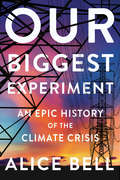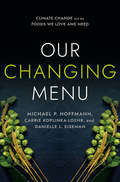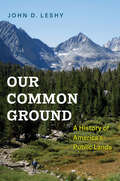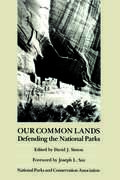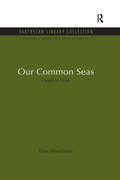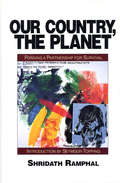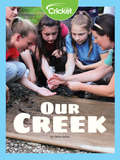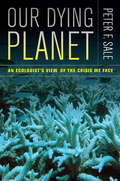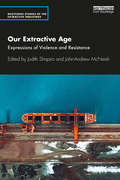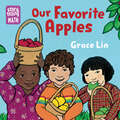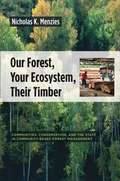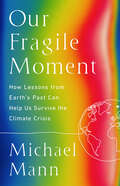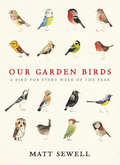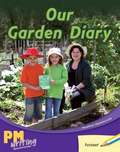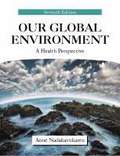- Table View
- List View
Our Biggest Experiment: An Epic History of the Climate Crisis
by Alice BellTraversing science, politics, and technology, Our Biggest Experiment shines a spotlight on the little-known scientists who sounded the alarm to reveal the history behind the defining story of our age: the climate crisis.Our understanding of the Earth's fluctuating environment is an extraordinary story of human perception and scientific endeavor. It also began much earlier than we might think. In Our Biggest Experiment, Alice Bell takes us back to climate change science's earliest steps in the eighteenth and nineteenth centuries, through the point when concern started to rise in the 1950s and right up to today, where the &“debate&” is over and the world is finally starting to face up to the reality that things are going to get a lot hotter, a lot drier (in some places), and a lot wetter (in others), with catastrophic consequences for most of Earth's biomes.Our Biggest Experiment recounts how the world became addicted to fossil fuels, how we discovered that electricity could be a savior, and how renewable energy is far from a twentieth-century discovery. Bell cuts through complicated jargon and jumbles of numbers to show how we're getting to grips with what is now the defining issue of our time. The message she relays is ultimately hopeful; harnessing the ingenuity and intelligence that has driven the history of climate change research can result in a more sustainable and bearable future for humanity.
Our Changing Earth: An Encyclopedia of Landforms (Into Reading, Level N #87)
by Darleen RamosNIMAC-sourced textbook <p><p> Our Earth is changing all the time. Earthquakes, wind, water, and ice all work to change the shape of Earth. Do you know which is the largest canyon on Earth?
Our Changing Menu: Climate Change and the Foods We Love and Need
by Michael P. Hoffmann Carrie Koplinka-Loehr Danielle L. EisemanOur Changing Menu unpacks the increasingly complex relationships between food and climate change. Whether you're a chef, baker, distiller, restaurateur, or someone who simply enjoys a good pizza or drink, it's time to come to terms with how climate change is affecting our diverse and interwoven food system. Michael P. Hoffmann, Carrie Koplinka-Loehr, and Danielle L. Eiseman offer an eye-opening journey through a complete menu of before-dinner drinks and salads; main courses and sides; and coffee and dessert. Along the way they examine the escalating changes occurring to the flavors of spices and teas, the yields of wheat, the vitamins in rice, and the price of vanilla. Their story is rounded out with a primer on the global food system, the causes and impacts of climate change, and what we can all do. Our Changing Menu is a celebration of food and a call to action—encouraging readers to join with others from the common ground of food to help tackle the greatest challenge of our time.
Our Choice: A Plan to Solve the Climate Crisis
by Al GoreIt is now abundantly clear that we have at our fingertips all of the tools we need to solve the climate crisis. The only missing ingredient is collective will. Properly understood, the climate crisis is an unparalleled opportunity to finally and effectively address many persistent causes of suffering and misery that have long been neglected, and to transform the prospects of future generations, giving them a chance to live healthier, more prosperous lives as they continue their pursuit of happiness. Our Choice gathers in one place all of the most effective solutions that are available now and that, together, will solve this crisis. It is meant to depoliticize the issue as much as possible and inspire readers to take action - not only on an individual basis but as participants in the political processes by which every country, and the world as a whole, makes the choice that now confronts us. There is an old African proverb that says, "If you want to go quickly, go alone; if you want to go far, go together." We have to go far, quickly. We can solve the climate crisis. It will be hard, to be sure, but if we can make the choice to solve it, I have no doubt whatsoever that we can and will succeed. - Al Gore, from the introduction.
Our Common Ground: A History of America's Public Lands
by John D. LeshyThe little-known story of how the U.S. government came to hold nearly one-third of the nation&’s land and manage it primarily for recreation, education and conservation. &“A much-needed chronicle of how the American people decided––wisely and democratically––that nearly a third of the nation&’s land surface should remain in our collective ownership and be managed for our common good.&”—Dayton Duncan, author of The National Parks: America&’s Best Idea America&’s public lands include more than 600 million acres of forests, plains, mountains, wetlands, deserts, and shorelines. In this book, John Leshy, a leading expert in public lands policy, discusses the key political decisions that led to this, beginning at the very founding of the nation. He traces the emergence of a bipartisan political consensus in favor of the national government holding these vast land areas primarily for recreation, education, and conservation of biodiversity and cultural resources. That consensus remains strong and continues to shape American identity. Such a success story of the political system is a bright spot in an era of cynicism about government. This book is essential reading for anyone who cares about public lands, and it is particularly timely as the world grapples with the challenges of climate change and biodiversity loss.
Our Common Lands: Defending The National Parks
by David J. Simon Joseph L. SaxThis accessible book explains the complexities of key environmental laws and how they can be used to protect our national parks. It includes discussions of successful and unsuccessful attempts to use the laws and how the courts have interpreted them.
Our Common Seas: Coasts in Crisis (Natural Resource Management Set)
by Don HinrichsenMost of the world's population lives on or near the coasts. Every nation not completely landlocked has used the sea as its supposedly self-cleansing garbage dump. Now the effects are being felt. There is not a coast in the world which is not dangerously polluted. Sewage, oil, plastics, industrial effluents, radioactive waste have been added to ungoverned development, all of which are busily destroying otherwise robust inshore eco-systems. Hinrichsen, basing his work on United Nations Environment Programme (UNEP) research and his own extensive travels, has described the situation in the Mediterranean, the Gulf, the Indian Ocean, the South-East Asian Seas and the Eastern Pacific. He covers both the disasters and the growing successes in dealing with them, and he points the way to the sort of international deal needed to rescue a vast resource in danger of complete destruction. His book is both a call to action and a sign of hope. Originally published in 1990
Our Country, The Planet: Forging A Partnership For Survival
by Seymour Topping Shridath S. RamphalOur Country, The Planet is a wide-ranging discussion of the global environmental crisis that accounts for the positions and perceptions of both developed and developing nations. As president of the World Conservation Union and the only person to have served on all five independent international commissions on global issues, Shridath Ramphal brings to his study a unique perspective and deep understanding of both development and the environment.
Our Creek
by Celina SeftasFollow along with this class as they explore a creek near their school in Pennsylvania! They want to learn about the water and its ecosystem, so they perform a survey to determine its quality and biota. What do you think they will find?
Our Dying Planet
by Peter SaleCoral reefs are on track to become the first ecosystem actually eliminated from the planet. So says leading ecologist Peter F. Sale in this crash course on the state of the planet. Sale draws from his own extensive work on coral reefs, and from recent research by other ecologists, to explore the many ways we are changing the earth and to explain why it matters. Weaving into the narrative his own firsthand field experiences around the world, Sale brings ecology alive while giving a solid understanding of the science at work behind today's pressing environmental issues. He delves into topics including overfishing, deforestation, biodiversity loss, use of fossil fuels, population growth, and climate change while discussing the real consequences of our growing ecological footprint. Most important, this passionately written book emphasizes that a gloom-and-doom scenario is not inevitable, and as Sale explores alternative paths, he considers the ways in which science can help us realize a better future.
Our Extractive Age: Expressions of Violence and Resistance (Routledge Studies of the Extractive Industries and Sustainable Development)
by Judith ShapiroOur Extractive Age: Expressions of Violence and Resistance emphasizes how the spectrum of violence associated with natural resource extraction permeates contemporary collective life. Chronicling the increasing rates of brutal suppression of local environmental and labor activists in rural and urban sites of extraction, this volume also foregrounds related violence in areas we might not expect, such as infrastructural developments, protected areas for nature conservation, and even geoengineering in the name of carbon mitigation. Contributors argue that extractive violence is not an accident or side effect, but rather a core logic of the 21st Century planetary experience. Acknowledgement is made not only of the visible violence involved in the securitization of extractive enclaves, but also of the symbolic and structural violence that the governance, economics, and governmentality of extraction have produced. Extractive violence is shown not only to be a spectacular event, but an extended dynamic that can be silent, invisible, and gradual. The volume also recognizes that much of the new violence of extraction has become cloaked in the discourse of "green development," "green building," and efforts to mitigate the planetary environmental crisis through totalizing technologies. Ironically, green technologies and other contemporary efforts to tackle environmental ills often themselves depend on the continuance of social exploitation and the contaminating practices of non-renewable extraction. But as this volume shows, resistance is also as multi-scalar and heterogeneous as the violence it inspires. The book is essential reading for activists and for students and scholars of environmental politics, natural resource management, political ecology, sustainable development, and globalization.
Our Favorite Apples: Our Favorite Apples (Storytelling Math)
by Grace LinCaldecott Honor winner Grace Lin celebrates math for every kid, everywhere!Manny, Olivia, and Mei go apple picking and sort their red, green, and yellow apples by color. But then they find an apple that&’s all three colors. What should they do? A playful exploration of sorting, classifying, and friendship.Storytelling Math celebrates children using math in their daily adventures as they play, build, and discover the world around them. Joyful stories and hands-on activities make it easy for kids and their grown-ups to explore everyday math together. Developed in collaboration with math experts at STEM education nonprofit TERC, under a grant from the Heising-Simons Foundation.
Our Forest, Your Ecosystem, Their Timber: Communities, Conservation, and the State in Community-Based Forest Management
by Nicholas MenziesCommunity-based forest management (CBFM) is a model of forest management in which a community takes part in decision making and implementation, and monitoring of activities affecting the natural resources around them. CBFM provides a framework for a community members to secure access to the products and services that flow from the landscape in which they live and has become an essential component of any comprehensive approach to forest management. In this volume, Nicholas K. Menzies looks at communities in China, Zanzibar, Brazil, and India where, despite differences in landscape, climate, politics, and culture, common challenges and themes arise in making a transition from forest management by government agencies to CBFM. The stories of these four distinct places highlight the difficulties communities face when trying to manage their forests and negotiate partnerships with others interested in forest management, such as the commercial forest sector or conservation and environmental organizations. These issues are then considered against a growing body of research concerning what constitutes successful CBFM.Drawing on published and unpublished case studies, project reports, and his own rich experience, Menzies analyzes how CBFM fits into the broader picture of the management of natural resources, highlighting the conditions that bring about effective practices and the most just and equitable stewardship of resources. A critical companion for students, researchers, and practitioners, Our Forest, Your Ecosystem, Their Timber provides a singular resource on the emergence and evolution of CBFM.
Our Fragile Moment: How Lessons from Earth's Past Can Help Us Survive the Climate Crisis
by Michael E. MannIn this sweeping work of science and history, the renowned climate scientist and author of The New Climate War shows us the conditions on Earth that allowed humans not only to exist but thrive, and how they are imperiled if we veer off course. For the vast majority of its 4.54 billion years, Earth has proven it can manage just fine without human beings. Then came the first proto-humans, who emerged just a little more than 2 million years ago—a fleeting moment in geological time. What is it that made this benevolent moment of ours possible? Ironically, it&’s the very same thing that now threatens us—climate change. The drying of the tropics during the Pleistocene period created a niche for early hominids, who could hunt prey as forests gave way to savannahs in the African tropics. The sudden cooling episode known as the &“Younger Dryas&” 13,000 years ago, which occurred just as Earth was thawing out of the last Ice Age, spurred the development of agriculture in the fertile crescent. The &“Little Ice Age&” cooling of the 16th-19th centuries led to famines and pestilence for much of Europe, yet it was a boon for the Dutch, who were able to take advantage of stronger winds to shorten their ocean voyages. The conditions that allowed humans to live on this earth are fragile, incredibly so. Climate variability has at times created new niches that humans or their ancestors could potentially exploit, and challenges that at times have spurred innovation. But there&’s a relatively narrow envelope of climate variability within which human civilization remains viable. And our survival depends on conditions remaining within that range. In this book, renowned climate scientist Michael Mann will arm readers with the knowledge necessary to appreciate the gravity of the unfolding climate crisis, while emboldening them—and others--to act before it truly does become too late.
Our Garden Birds: a stunning illustrated guide to the birdlife of the British Isles
by Matt SewellIn this beautiful gift edition, pop-art street artist Matt Sewell offers his own unique take on 52 of our favourite British garden birds.'An offbeat book featuring 52 charming characterful illustrations of our best-loved British birds' -- BBC Wildlife'A treasure to behold' -- ***** Reader review'Quirky, creative but very well-observed' -- ***** Reader review'This book should be owned by all garden bird lovers!' -- ***** Reader review'Absolutely love this book!' -- ***** Reader review'Utterly charming!' -- ***** Reader review*************************************************************************************Since its first appearance in July 2009, Matt's 'Bird of the Week' feature for the Caught by the River website has quickly become a cult hit.His pop-art watercolours are distinctive and enchanting, as are his innovative descriptions, which see great tits 'bossing the other birds around', the 'playful yet shy buoyancy' of bullfinches and the 'improbable' nature of the waxwing ('like a computer-generated samurai finch').This witty, delightful and distinctive gift book will appeal to bird watching enthusiasts, children and adults, and art and illustration fans alike.
Our Garden Diary (Into Reading, Level J #38)
by Heather Hammonds Lyz Turner-Clark Rachel TonkinNIMAC-sourced textbook <p><p>A non-fiction recount about the growth of plants: this story was written by a boy. It is about what happened when his Aunty Sue helped him and his sister Katie to grow some beans.
Our Gift to the Beach: Level C (Into Reading, Level D #14)
by Margarita González-Jensen Richard HutchingsA messy beach is no fun. A girl and her mom help the beach.
Our Global Environment: A Health Perspective (7th edition)
by Anne NadakavukarenA broad survey of the major environmental issues facing the world today. The dual approach describes the ecological impact of various human activities combined with specific issues of personal and community health, and emphasizes the interrelatedness of the two. Topics include depletion of the ozone layer and its consequences, global warming, current policy options for reducing carbon dioxide emissions, the disappearing Aral Sea, Everglades restoration, the deadly bacteria, and environmental racism. Annotation c. by Book News, Inc. , Portland, Or.
Our Great Big Backyard
by Laura Bush Jenna Bush Hager#1 New York Times bestselling authors former First Lady Laura Bush and her daughter Jenna Bush Hager have created an exuberant picture book tribute to our national parks and the importance and fun of connecting with nature.Our Great Big Backyard follows Jane, whose plans of spending the summer playing video games with her friends are dashed when her parents announce that her family is going on a road trip to national parks around the country. Yet somewhere between the Everglades and Big Bend National Park, things begin to change.Jane starts paying attention to the magnificent sights and spends less time looking at her screen. The stunning views open up her imagination as she and her brother see everything that nature has to offer. And the more Jane discovers, the more she realizes how much there is to love about the outdoors—whether she’s in a national park across the country or right in her own backyard.
Our Green Heart: The Soul and Science of Forests
by Diana Beresford-KroegerIn this inspiring culmination of Diana Beresford-Kroeger&’s life&’s work as a botanist, biochemist, biologist and poet of the global forest, she delivers a challenge to us all to dig deeper into the science of forests and the ways they will save us from climate breakdown—and then do our part to plant and protect them.As the last child in Ireland to receive a full Druidic education, Diana Beresford-Kroeger has brought an unusual and ancient holistic attitude to the science of trees, which has led her to many fresh insights into how closely we are tied to one another and to the natural world. Her influential message is to pay rapt attention to trees, because they are the green heart of the living world. Forests are our lungs, our medicine, our oxygen and the renewal of our soil. Planting the right trees in the right places, protecting the last virgin forests and working to create new ones is our best means to ensure a future for our children and grandchildren on this burning earth.Each of the essays gathered in Our Green Heart show us a slice of the natural world through Diana&’s unique lens, illuminating the way our health, individually and as a species, is tied to the health of the forest—a tie we ignore at our peril. She maps the science that still needs to be done—there is so much we don&’t know about the ways trees and forests work—but also, eloquently, shows us the path to survival that her own science has revealed, the &“bioplan&” or blueprint for the connectivity of life in nature. If we realize that even the flowerpot on our doorstep is a natural habitat, and plant it according to its bioplan, we will be aiding and abetting life rather than destroying it.
Our Hands Hold Violence: Poems
by Kieron WalquistA NATIONAL POETRY SERIES WINNER SELECTED AND WITH A FOREWORD BY BRENDA HILLMAN A collection of poems that explores rural Missouri, violence, queer desire / intimacy, addiction, familial and wildlife relationshipsThrough encounters with the everyday beauty and brutality so much a part of rural and urban Missouri, Our Hands Hold Violence explores what it means to experience and/or perpetuate small and significant acts of violence, toward others and the self.What does it mean to hunt (be hunted), haunt (be haunted), and other (be othered)? Abiding by a chronological arc told in four movements (HERE, THERE, TOGETHER, ALONE), OHHV follows the speaker(s) as they come up in the Show Me State and come to terms with queerness, mental disability, addiction, and loneliness in the largely Christian, conservative, and hyper-masculine landscape. Other themes / aspects of note include familial dynamics, estrangement, labor, neglected and decaying natures, waste, and the confluence of wildlife and mankind.Comprised of traditional forms and modes such as the abecedarian, ekphrasis, sestina, and more hybrid configurations (billboards, bullet points, McDonald&’s Monopoly stickers), as well as photographs, OHHV is interested, too, in changing/challenging structure and expectations. Thus, enacting a visual and figurative &“violence&” upon the page. Additionally, two poems are contained in a nonce (invented) form called &“Shakes,&” where strophes traverse between left and right points, while the middle column is constructed or cataloged by similar sounds—a form inspired by the author&’s own reality of stimming (i.e. pacing) and echolalia.OHHV indulges in alliteration, assonance, repetition, and a colloquial registry of language. The voice(s) in the poems can range from anxious, reflective (nostalgic), sensual, and tender, but all are compelled by and circle the manuscript&’s themes, which become obsessions. Hauntings. Ultimately, OHHV is a collection troubled by the desire to belong to/in a place and to beloveds that have &“been home&” while, in ways, &“feeling like an outsider&” at home and within one&’s local community.
Our House Is Round: A Kid's Book About Why Protecting Our Earth Matters
by Yolanda Kondonassis Joan BrushCalled "the perfect children's introduction to environmental issues" by Fred Krupp, president of the Environmental Defense Fund, Our House Is Round gently guides young readers through a smartly narrated conversation illuminating the concept of global connection and environmental cause and effect. This book teaches the "whys" behind earth conservation in a colorful, positive way that encourages maturity, responsibility, and problem-solving discussion. Author Yolanda Kondonassis encourages children to answer questions about their planet and discusses the issues of global warming, recycling, energy conservation, planting trees, and more. This book is a must for every school and family library.
Our House Is on Fire: Scenes of a Family and a Planet in Crisis
by Greta Thunberg Malena Ernman Beata Ernman Svante Thunberg"A must-read ecological message of hope . . . Everyone with an interest in the future of this planet should read this book." --David Mitchell, The GuardianWhen climate activist Greta Thunberg was eleven, her parents Malena and Svante, and her little sister Beata, were facing a crisis in their own home. Greta had stopped eating and speaking, and her mother and father had reconfigured their lives to care for her. Desperate and searching for answers, her parents discovered what was at the heart of Greta&’s distress: her imperiled future on a rapidly heating planet. Steered by Greta&’s determination to understand the truth and generate change, they began to see the deep connections between their own suffering and the planet&’s. Written by a remarkable family and told through the voice of an iconoclastic mother, Our House Is on Fire is the story of how they fought their problems at home by taking global action. And it is the story of how Greta decided to go on strike from school, igniting a worldwide rebellion.
Our Life In Gardens
by Joe Eck Wayne WinterrowdTwo renowned garden designers present this entertaining, fascinating, and unexpectedly moving book about the life and garden they share. The book also contains much sound information about the cultivation of plants and their value in the landscape.
Our Livable World: Creating the Clean Earth of Tomorrow
by Marc SchausA vital guide to the frontlines of our fight against climate change and the scientific and technological innovations that will revolutionize the world. The United States&’ accelerated plans to combat the existential threat of climate change finally give reason to hope. In Our Livable World, research specialist and author Marc Schaus explores the incredible new green innovations in science and engineering that can allow us to avoid the worst repercussions of global warming as we work to usher in a sustainable, livable world. To beat a challenge the size of climate change, our solutions will have to be ambitious: solar thermal cells capable of storing energy long after the sun goes down, &“smart highways&” designed to charge your vehicle as you drive, indoor vertical farms automated to maximize crop growth with no pesticides, bioluminescent vines ready to one day replace our streetlights, jet fuel created from landfill trash—and next-generation carbon capture techniques to remove the emissions we have already released over the past several decades. Far from the geoengineering schemes of cli-fi action thrillers, real solutions are being developed, right this moment. Our Livable World features interviews with the innovators, real talk on the revolutionary technology, and a clear picture of a cleaner planet in the future. &“An important book that shows the dawn of a new kind of environmental movement―an age where we invest in deeply creative and fascinating technical solutions that work in harmony with the Earth. Marc Schaus lays out the exciting future of environmental innovation before us.&” —Katie Patrick, author of How to Save the World
